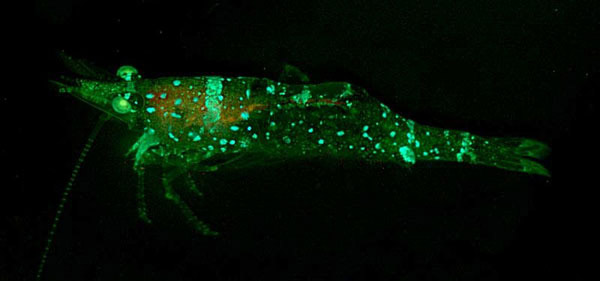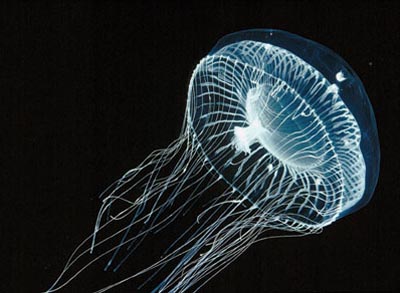Bioluminescence is the light produced by a chemical reaction that occurs in an organism.
Bioluminescence is the only source of light in the deep ocean where sunlight does not penetrate. Amazingly, about ninety percent of the organisms that live in the ocean have the capability to produce light.
Most bioluminescence is blue for two reasons. First, blue-green light travels the farthest in water. Second, most organisms are sensitive to only blue light. They do not have the visual pigments to absorb the longer or shorter wavelengths. As with every rule, exceptions exist. Some cnidarians emit green light and one family of fish, the Malacosteids (known as the Loosejaws) emit and are able to see red light. The red light they produce is almost infrared and not visible to the human eye. This is a huge advantage to these fish because they can produce light to see their prey, but their prey can not see them!

The luminescence of photosynthetic dinoflagelletes is very much influenced by the intensity of the previous days sunlight. The brighter the sunlight, the brighter the luminescence will be. In most multi-cellular organisms, the ability to produce light is controlled neurally. However, the transmitter that signals the change to take place is unknown in most organisms.
All bioluminescent reactions occur in the presence of oxygen. Two types of chemicals are required- a luciferin and a luciferase (lucifer means light bringing). The luciferin is the basic substrate of the reaction and produces the light. The luciferase catalyzes the reaction. In the basic reaction, the luciferase catalyzes the oxidation of luciferin, which results in two products- light and inactive oxyluciferin. Most of the energy released in this reaction occurs in the form of light, therefore, bioluminescence is commonly called “cold light.”
Five main types of luciferins are known.
1.Bacterial Luciferin is a reduced riboflavin phosphate and found in bacteria, some fish, and squid.

2. Dinoflagellate Luciferin is thought to be derived from chlorophyll because it has similar structure and is found in dinoflagellates and euphasiid shrimp.

3. Vargulin, is found in the ostracod Vargula and is also used by the midshipman fish Poricthys. This is an interesting dietary link because the fish can not luminesce until they are fed luciferin bearing food.
4. Coelenterazine is the most common luciferin; it is found in many phyla- the radiolarians, ctenophores, cnidarians, squids, copepods, chaetognaths, and some fish and shrimp.

5. Firefly luciferin, which requires ATP as a cofactor in its reactions.


Glow worms: http://www.youtube.com/watch?v=kBIEmjaoE5w
ReplyDeleteMycena Chlorophos: http://natureisthebestdesigner.com/luminescent/mycena-chlorophos/
ReplyDelete